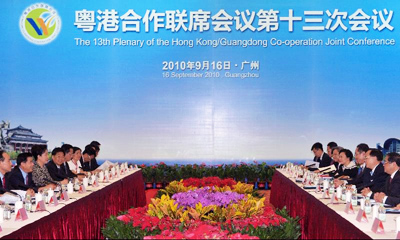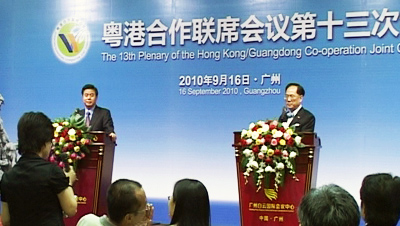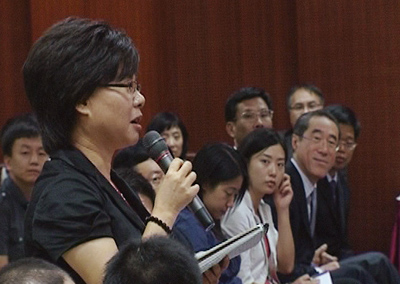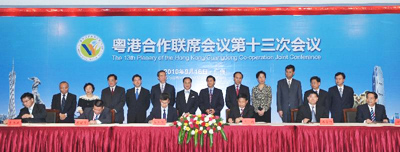|
16 September, 2010
The 13th Plenary of the Hong Kong/Guangdong Cooperation Joint Conference
Dim Sum TV Reporter: How will the two sides remove barriers to co-operation?
The 13th Plenary of the Hong Kong/Guangdong Cooperation Joint Conference was held in Guangzhou on September 16. Mr. Donald Tsang, Chief Executive of the Hong Kong Special Administrative Region, and Mr. Huang Hua Hua, Governor of Guangdong Province, co-chaired the conference. One of the key items on the agenda was turning the macro policies of the Outline of the Plan for the Reform and Development of the Pearl River Delta into concrete measures that are conducive to the development of both areas.
Hong Kong and Guangdong signed the Framework Agreement in Beijing in April. This is the first agenda on Hong Kong/Guangdong co-operation ever endorsed and approved for implementation by the State Council since the establishment of the Joint Conference 1998. Currently, the HKSAR Government and Guangdong Provincial Government are working closely to actively implement the various policies and measures in the Framework Agreement. Good progress has been made in the 43 projects of the 2010 Work Plan, with concrete results expected within 1 to 2 years.

Mr. Donald Tsang, Chief Executive of the HKSAR (right), and Mr. Huang Hua Hua, Governor of Guangdong Province, shaking hands before the conference.

Mr. Donald Tsang (2nd from right) and Mr. Huang Hua Hua (2nd from left), co-chairing the conference.
After the conference, Mr. Tsang and Mr. Huang held a press briefing, during which media representatives were selected for a question-and-answer session, including Dim Sum TV’s reporter. In his question, our reporter referred to the last joint conference, when Mr. Tsang said that the main door to co-operation had been opened, though a number of smaller doors remained closed. Our reporter asked Mr. Tsang which smaller doors were now open, and which ones were still closed? What proactive measures would it take to remove these barriers?

Dim Sum TV’s reporter (standing) posing his question.

“I’m a reporter from Dim Sum TV. I have a question for Mr. Tsang . . . “ Second from right, front row, is Mr. Henry Tang, Chief Secretary for Administration of the HKSAR
In his reply, Mr. Tsang said that with each joint conference, many doors had been opened. The process, however, would take time. Each new agreement brings with it numerous related issues that need to be addressed. There is much work to be done, both on a national policy level and on a provincial administrative level, most notably through the joint conferences between Hong Kong and Guangdong. To resolve the concrete issues is to unlock the smaller doors. At the same time, many new, main doors have sprung up. For example, renminbi business. How best to undertake this project, which has ramifications that extend to regional and municipal levels. Only when the work is done and done well on each level can all the obstacles be removed.
Mr. Tsang expressed confidence and optimism in the progress of the work. With the foundation as well as national policies in place, more and more doors will be opened. Once Hong Kong/Guangdong cooperation has been incorporated into The National 12th Five-Year Plan, more agreements will come, and with them, more opportunities.

Mr. Tsang and Mr. Huang witnessing the signing of another agreement strengthening Hong Kong-Guangdong cooperation.
During the joint conference, the two sides reached an understanding on the acceleration of two key projects, Building a Quality Living Zone and Infrastructure Construction, in order to promote the development of three key co-operative zones: Qianhai in Shenzhen, Nansha in Guangzhou, and the Shenzhen/Hong Kong Bay Area. Co-operation in six key areas – trade investment, infrastructure construction and customs protocols, service industries, financial services, education and health, environmental protection – will also be intensified.
An additional four agreements were signed by the two sides: the Arrangement on the Implementation of the Framework Agreement on Hong Kong/Guangdong Co-operation, the Co-operation Agreement between Guangdong and Hong Kong on Quality Agricultural Products, the Guangdong and Hong Kong Co-operation Arrangement on Search and Rescue at Sea, the Agreement on Joint Promotion of Hong Kong/Guangdong Industry-Academia-Research Co-operation.
|

